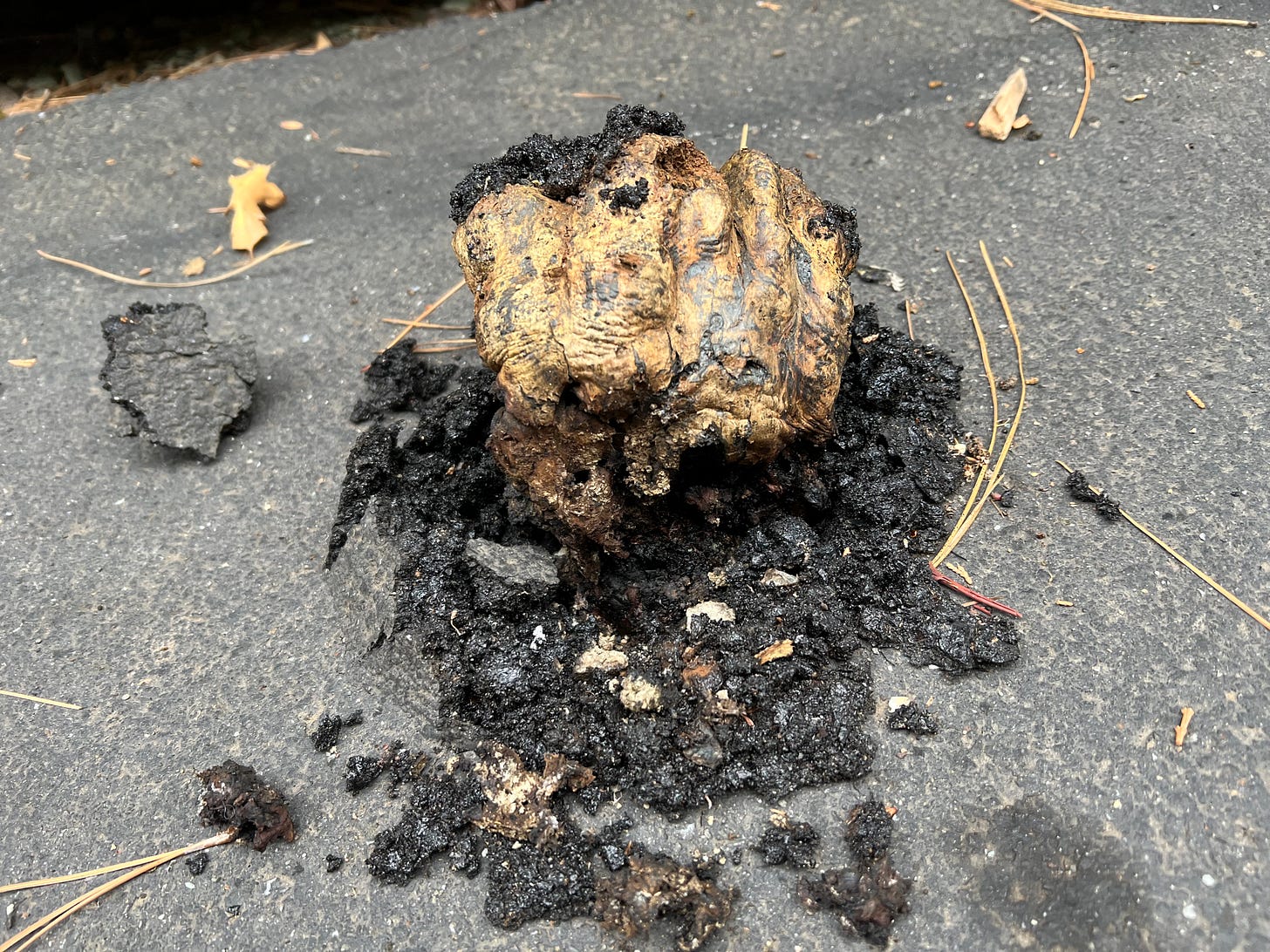The Mushroom and the Mission
Like aliens popping up through my driveway
The Mushroom and the Mission
By Jim Reynolds | www.reynolds.com
It looked like a clump of dirt, maybe an old tree root, sitting on the blacktop. I had been away from my home in the woods for several months, and when I returned, there they were: strange, almost alien-like structures poking up through my driveway.
Usually I catch them before they break through—just a swelling bump under the pavement, which I pry out like a bad tooth. But this time the mushroom had already won the battle.
Not once, not as an oddity—this happens every year. Something hidden below, probably a decaying tree limb or root system, is feeding it. But this one wasn’t the kind you slice into a salad. It was massive—eight inches tall, four to five inches wide, hardened and shaped like a clenched fist. Not soft, not fragile, but built for battle. As if nature had designed it for exactly this: to push through pavement.
That organism, born in darkness, had done what gravel, asphalt, and steamrollers could not prevent: it had forced its way to the light.
Mushrooms don’t move fast. They don’t roar or tear or break with sudden force. Their power is quieter—relentless pressure applied over time. Underground, their mycelium spreads, digesting what’s dead, recycling it into life, probing every crack. When it’s time to reproduce, they have no choice but to push upward. Against all odds, they rise.
We tend to think of mushrooms as background noise—odd little umbrellas in the yard, or mold on a forgotten piece of cheese in the back of the fridge. But they’re not incidental; they’re essential.
There are the tiny white caps that pop up overnight in circles across a suburban lawn, marking the silent work of an underground network. There are the lace-like shelves climbing up the trunk of an ancient dying oak, decorating its decline while hastening its return to soil. There are the brilliant red and orange ones you stumble across deep in the woods, exotic and almost otherworldly. We ignore them, even dismiss them, but they are nature’s final actors—the recyclers, the re-creators.
Their mission is always the same: to return what has died to the living. Fungus breaks down what no one else can, turning the massive carcass of a fallen tree into the fertile base for the next generation of seedlings. The forest cannot go on without them. They may look soft, even disposable. But they are the silent rejuvenators of the world.
Look closely at the one in my driveway and it resembles a fist. A stubborn, oversized fist punching up through the pavement. It’s nature’s way of saying:
“You cannot dissuade me. You cannot defeat me. I will not give up. I was doing this before you came. I will do it after you are gone. I have a mission to complete, and I will complete it.”
The mushroom doesn’t complain about its burden. It doesn’t calculate the odds. It doesn’t stop to ask if the asphalt is too thick. It just pushes, day and night, until the job is done.
That is the quiet law of nature: persistence beats resistance. What looks fragile is often unstoppable when it knows its purpose. The mushroom’s mission is certain, its determination absolute.
Maybe that’s why its fist through the pavement is so striking. It isn’t just biology—it’s a reminder. Obstacles are inevitable, but surrender is optional. Life prevails because it refuses to quit.
So it is with us. If we know what we are here to do—what we must build, protect, and pass on—then we cannot afford hesitation. We don’t need bluster, only resolve. Steady pressure. Relentless certainty in the mission.
If you doubt it, look at the mushroom punching through asphalt. Hardened, fist-shaped, patient, relentless—and victorious.
The Mushroom’s Creed
Beneath the stone, beneath the tar,
I push and press for who I are.
No teeth to bite, no claw to fight,
I rise by day, I rise by night.
The hard may boast, the strong may stay,
but patient soft will find a way.
I do not yield, I do not rust—
I break the world by quiet trust.




Beautiful!